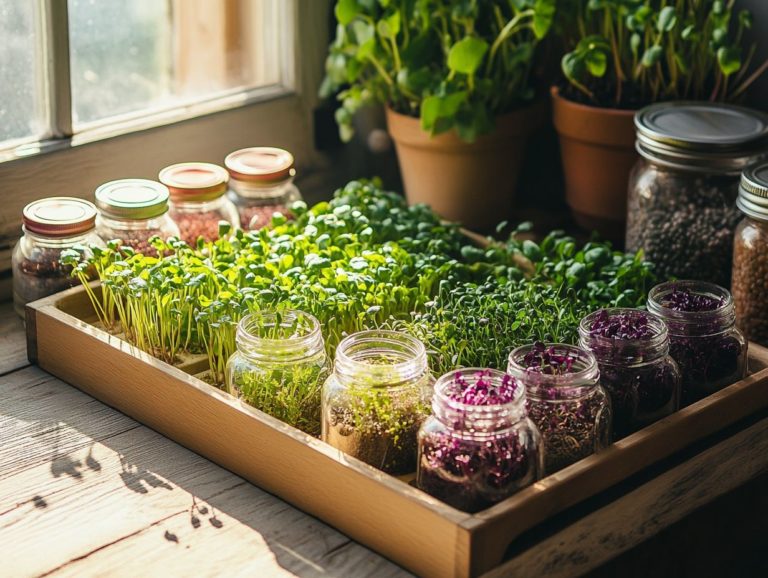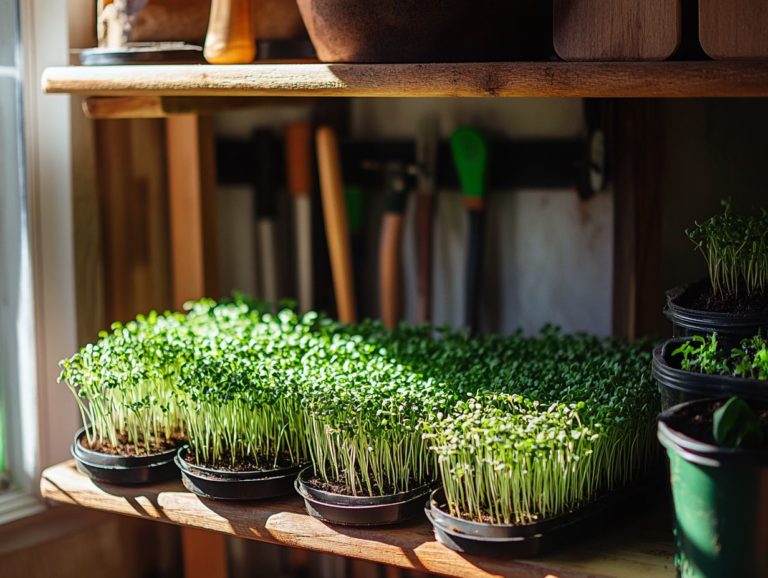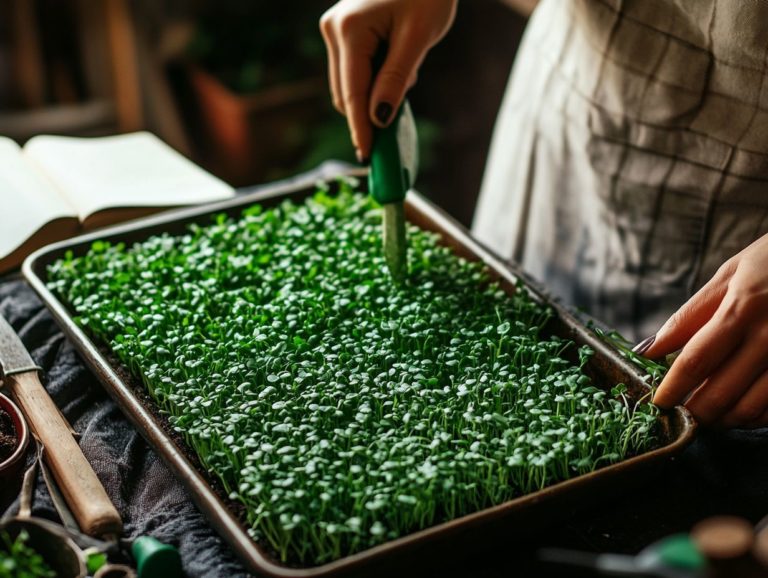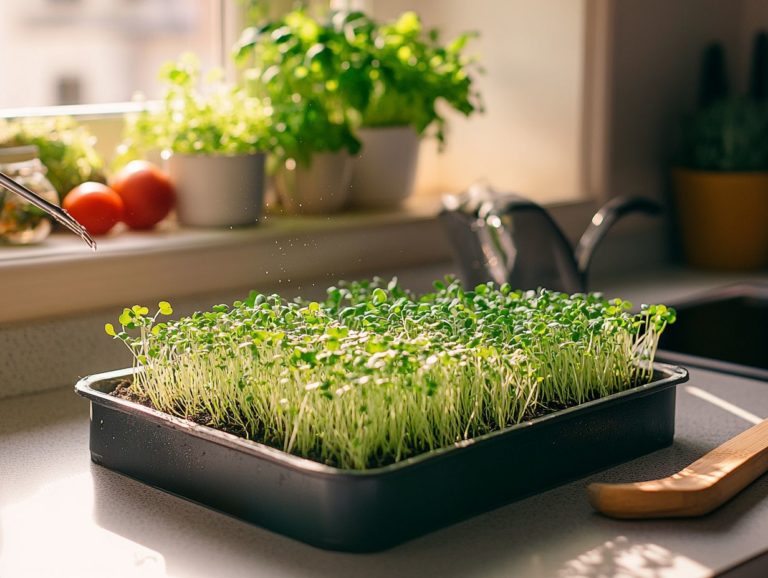Using Natural Fertilizers for Microgreen Growth
Microgreens have truly revolutionized the culinary and health landscapes, delivering an exquisite burst of flavor and nutrition. One popular variety is Purple Vienna Kohlrabi, often cultivated with Hero Organic Plant Food.
The secret to flourishing microgreens is rooted in the soil. This article delves into the advantages of using natural fertilizers, such as liquid fertilizer, a nutrient-rich solution that helps plants grow, providing a comparison between organic and synthetic options along with their respective environmental impacts.
You ll discover various types of natural fertilizers, such as compost and manure, and gain practical tips to optimize growth and enhance nutrient content for your growing microgreens.
Whether you re a seasoned gardener or embarking on your green journey, get ready to discover valuable insights to elevate your growing experience with products from Natures Lawn and Garden.
Contents
- Key Takeaways:
- Benefits of Using Natural Fertilizers
- Types of Natural Fertilizers
- Natural Fertilizers Can Supercharge Your Microgreens!
- Essential Tips for Boosting Microgreens Growth and Nutrient Value
- Frequently Asked Questions
- What are natural fertilizers and how do they benefit microgreen growth?
- What are some examples of natural fertilizers that can be used for microgreens?
- How often should natural fertilizers be applied to microgreens?
- Can natural fertilizers be harmful to microgreens if overused?
- Are natural fertilizers safe for consumption in microgreens?
- Are natural fertilizers more expensive than chemical fertilizers?
Key Takeaways:
- Natural fertilizers, such as compost and manure, offer numerous benefits for microgreen growth: promoting organic farming, reducing environmental impact, and increasing nutrient content. Products like Happy Frog Jump Start can also aid in this process.
- When using natural fertilizers for microgreens, consider application methods, dilution rate, and timing for maximum growth and nutrient absorption.
- Opting for natural fertilizers like Ocean Solution instead of synthetic options leads to healthier plants and more sustainable farming practices.
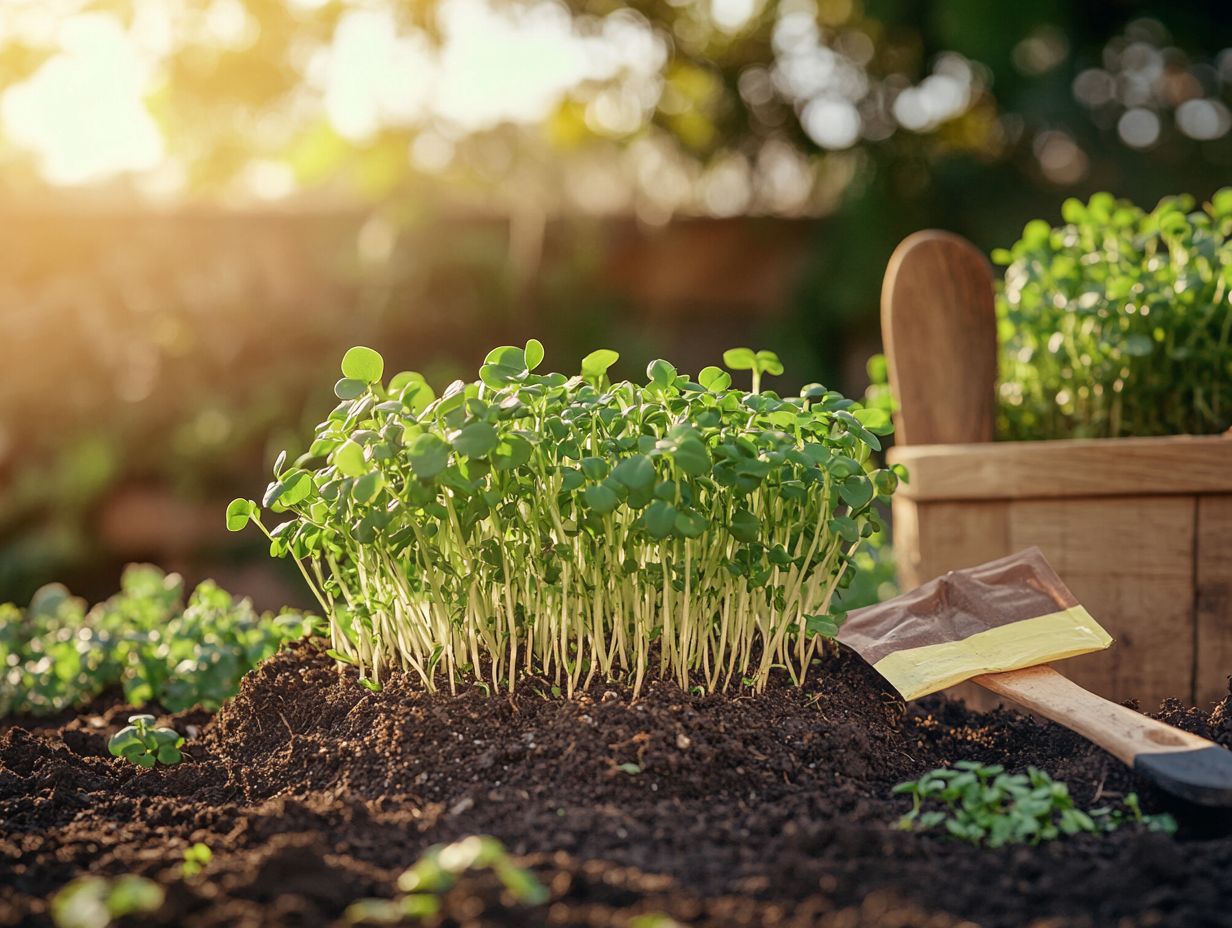
What are Microgreens?
Microgreens are young, edible plants that you can harvest just after the first true leaves have developed. They re brimming with flavor, nutrients, and health benefits. Varieties like Purple Vienna Kohlrabi and Genovese Basil have become favorites among home gardeners and chefs, making them a coveted ingredient in the culinary world.
You can easily grow them in various soil media, including coconut coir, which enhances water retention and aeration, ensuring optimal growth conditions for these nutrient-dense plants.
Beyond just taste, microgreens bring a delightful array of textures and colors, elevating any dish from salads to gourmet entrees. Their nutritional profile is impressive, offering concentrated vitamins and minerals that support overall health. Varieties such as Arugula, Radish, and Beet Greens not only introduce unique flavors but also deliver a substantial dose of antioxidants.
These vibrant greens thrive in well-draining soil and require minimal space, making them perfect for both indoor and outdoor gardening whether you opt for small pots or larger trays.
As culinary enthusiasts like you continue to explore the endless possibilities of microgreens, their presence on plates grows, providing both aesthetic appeal and a valuable nutritional boost.
Benefits of Using Natural Fertilizers
Natural fertilizers present a wealth of benefits for your microgreen cultivation, delivering a balanced nutrient solution that not only boosts plant growth but also fosters healthy soil practices and ecological sustainability.
By incorporating organic options like Hero Organic Plant Food, you can cultivate lush microgreen varieties such as Genovese Basil and Purple Vienna Kohlrabi, transforming your harvest into a flavorful and nutritionally rich bounty.
Natural fertilizers are safer for pets and the environment, positioning them as a responsible choice for the conscientious gardener you aspire to be.
Organic vs. Synthetic Fertilizers
Organic fertilizers come from natural sources and are often seen as a superior choice compared to synthetic options. Their sustainable nature and holistic benefits enhance both plant vitality and soil health.
The makeup of organic fertilizers includes valuable materials like compost, manure, and bone meal. These materials release nutrients gradually, fostering balanced growth over time. In contrast, synthetic fertilizers consist of chemically formulated compounds that deliver quick results but can disrupt the soil’s natural microbiome, which is the community of microorganisms that helps plants grow. While the immediate effects of synthetic fertilizers may seem appealing, they carry long-term risks such as nutrient runoff and soil erosion.
Understanding the benefits of each type of fertilizer is essential, especially when you aim to grow a healthy garden. For instance, organic fertilizers improve soil structure and enhance water retention. By taking proactive measures like regular soil testing, you can identify the best nutrient mix for your plants, ensuring their health and the integrity of the environment.
Environmental Impact
Consider the powerful impact fertilizers have on our environment! The environmental impact of fertilizers is a pivotal consideration in sustainable gardening practices, especially when growing microgreens. By choosing natural fertilizers, like organic options, you can significantly boost soil health and biodiversity while minimizing negative effects like chemical runoff that threaten aquatic ecosystems.
Opting for organic fertilizers makes your gardening practices environmentally friendly and sustainable, benefiting both your plants and the planet. The excessive reliance on synthetic fertilizers raises serious concerns about soil degradation and the disruption of essential nutrient cycles. This not only harms the immediate environment but also poses long-term risks, such as reduced soil fertility and an increasing dependence on chemical inputs.
In contrast, organic fertilizers promote a healthier ecosystem by enhancing the soil microbiome. This builds resilience against pests and diseases. By embracing these natural alternatives, you’re not just nurturing nutrient-rich microgreens; you re also supporting a healthier environment and positively impacting local biodiversity and water quality.
Types of Natural Fertilizers
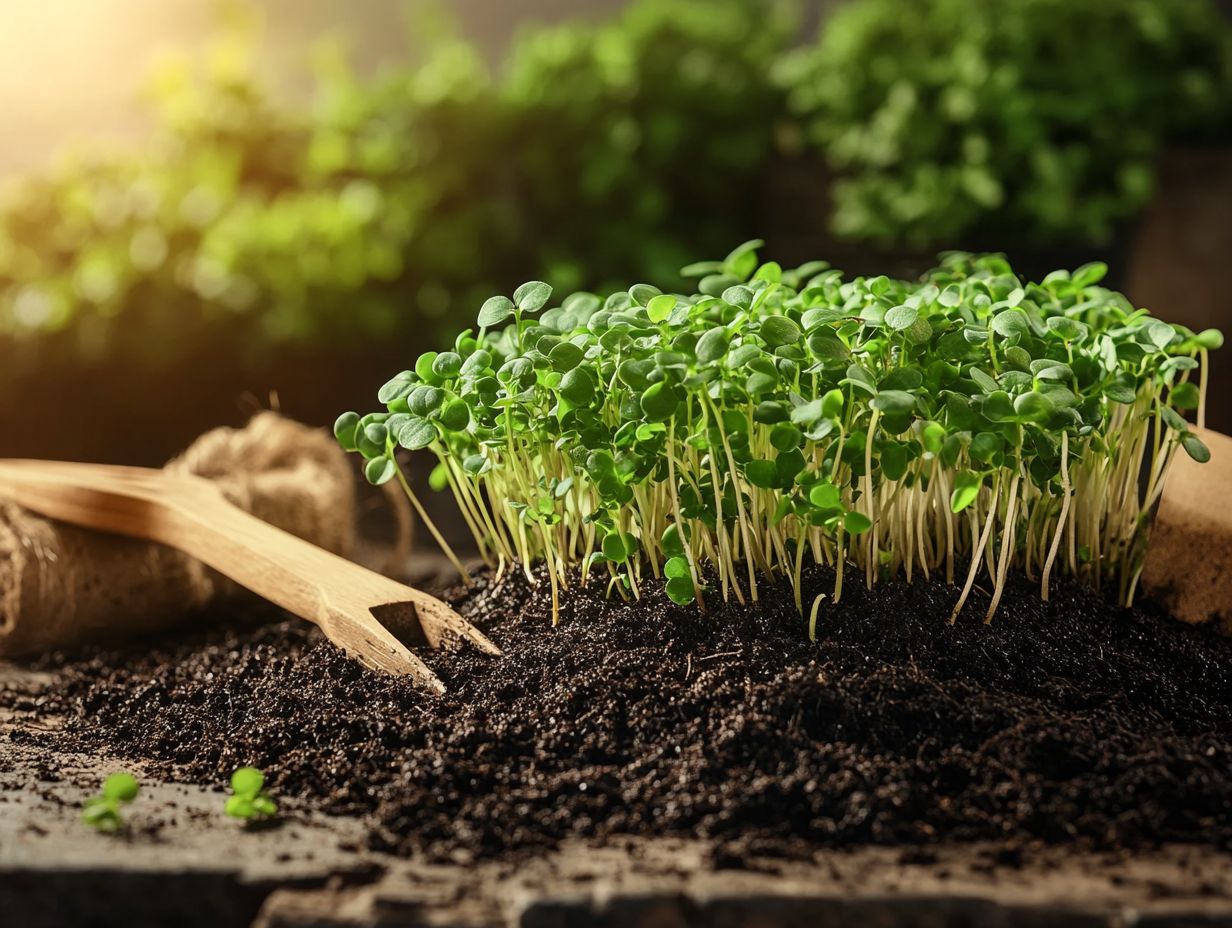
You have various natural fertilizers at your disposal that can significantly nourish your plants, particularly when it comes to growing microgreens like Red Acre Cabbage. Consider options such as compost, manure, and bone meal each offering a unique nutrient profile that can enhance plant growth and health.
By opting for these organic fertilizers, you’re not only improving soil structure but also championing sustainable gardening practices. This approach ensures that your microgreen crops thrive in a nutrient-rich environment, setting the stage for a flourishing garden.
Compost
Compost is a premium organic fertilizer made from the decomposition of plant and animal materials. It is highly valued in gardening for its remarkable ability to improve soil structure while providing a balanced nutrient solution. When you use compost for growing microgreens, it enhances moisture retention and promotes healthy root growth, making it the perfect choice for home gardeners eager to cultivate nutrient-dense varieties like Genovese Basil or Purple Vienna Kohlrabi.
Rich in essential nutrients such as nitrogen, phosphorus, and potassium, compost is crucial for robust plant development. Creating your own compost can be surprisingly straightforward; by layering kitchen scraps like vegetable peels, coffee grounds, and yard waste, you can nurture a thriving compost pile over time.
To maximize the benefits of compost with microgreens, ensure the compost is well-aged and free from pathogens. This cultivates an optimal growing environment and enhances the taste and nutritional profile of your greens.
Ultimately, integrating high-quality compost into your gardening routine boosts your yields and supports sustainable practices, helping to create a flourishing ecosystem.
Manure: An Excellent Choice for Your Garden
Manure is a classic organic fertilizer, renowned for its impressive nutrient content, especially nitrogen, which is vital for thriving plant growth. Properly aging or composting manure transforms it into a powerful nutrient solution specifically for growing microgreens, supplying essential elements for vigorous growth while boosting soil health and microbial activity.
This makes it particularly advantageous when cultivating varieties like Purple Vienna Kohlrabi and Genovese Basil.
There are various types of manure, each with unique nutrient content that fits different plants. For example, cow manure is well-balanced and versatile, making it a favored option among gardeners due to its slow nutrient release.
In contrast, chicken manure is a nitrogen powerhouse but requires careful handling. Its high concentration can scorch sensitive seedlings if not diluted appropriately.
Horse manure, often abundant and readily available, is packed with organic matter, enhancing air circulation in the soil and moisture retention.
To achieve optimal results, it’s crucial to compost these manures for several months before application. This ensures that nutrients are well-balanced in your nutrient solution, eliminates any pathogens, and makes nutrients readily accessible for your microgreens.
Using proper application methods can significantly enhance plant growth. Consider applying a thin layer as a top dressing or mixing it into the soil for best results.
Bone Meal: An Excellent Choice for Gardeners
Bone meal is an excellent choice for gardeners, serving as a slow-release organic fertilizer bursting with phosphorus that nurtures strong root development and vibrant flowering in plants. It’s particularly superb for cultivating microgreens.
When mixed into your soil media, it delivers a steady stream of nutrients that support a variety of microgreen favorites, ultimately resulting in a more flavorful and nutrient-dense harvest.
Apply about 1 to 2 tablespoons per square foot of soil for user-friendly and efficient results. This gradual nutrient release helps you avoid the pitfalls of over-fertilization and ensures your plants are well-supported throughout their growth cycle.
Unlike synthetic fertilizers that can cause rapid spikes in nutrient levels, bone meal provides a more balanced and eco-friendly alternative. This choice nurtures healthier, more robust microgreens while enhancing soil quality over time, showcasing the benefits of opting for this organic solution.
Natural Fertilizers Can Supercharge Your Microgreens!
Using natural fertilizers for microgreens can greatly enhance their growth and nutritional value. Grasping the best application methods is essential for achieving optimal results.
Whether you choose compost, manure, or bone meal, customize your approach according to the specific nutrient needs of the microgreens you re cultivating.
Consider conducting a fertilizer test to pinpoint the most effective nutrient solution tailored to your plants’ requirements. Don’t miss out on the benefits of these natural fertilizers for your garden!
Start experimenting with these fertilizers today to see the incredible difference in your microgreens!
Application Methods
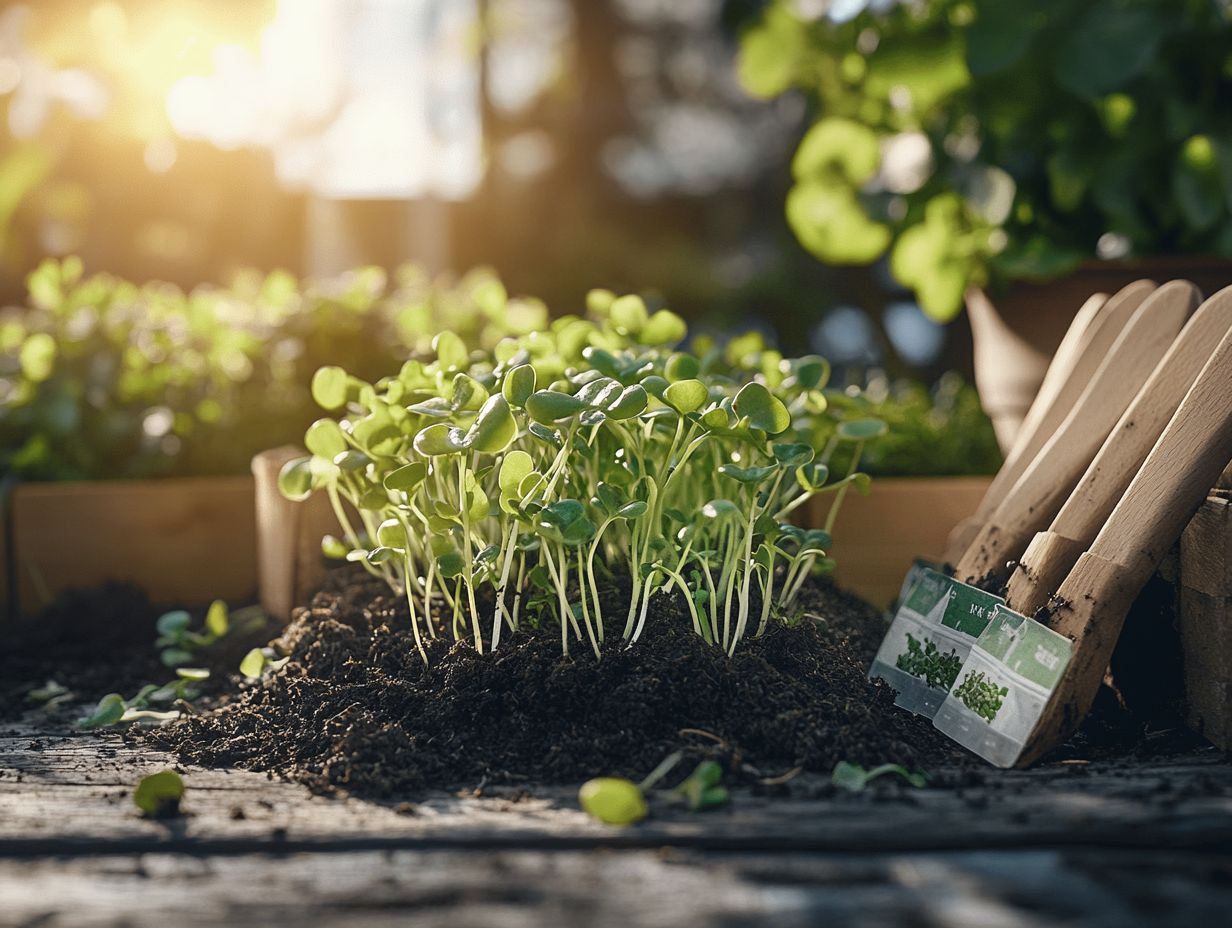
Application methods for natural fertilizers can vary significantly. They typically fall into two primary categories: solid and liquid fertilizers. Each offers distinct advantages when cultivating microgreens.
Liquid fertilizers present immediate nutrient availability. They are perfect for applying nutrients directly to the leaves or drenching the soil media. In contrast, solid fertilizers, like compost or organic granules, release nutrients more gradually. This promotes sustained growth for varieties such as Genovese Basil and Purple Vienna Kohlrabi.
When determining the optimal fertilization method, consider factors like the growth stage of your microgreens, their specific nutrient needs, and the surrounding environmental conditions. For instance, during the initial germination phase, liquid fertilizers can be particularly advantageous. Their rapid absorption rates ensure young seedlings receive essential nutrients without undue stress.
As your microgreens mature, transitioning to solid fertilizers can enhance their health and vigor. This is especially true for nutrient-hungry varieties like Arugula and Mustard Greens. Mastering the right timing and balancing these methods can lead to healthier crops and impressive yields.
Essential Tips for Boosting Microgreens Growth and Nutrient Value
To maximize growth and enhance nutrient content in your microgreens, embrace a blend of effective fertilization practices and strategic timing. By consistently integrating organic fertilizers, such as Hero Organic Plant Food, into your growth regimen, you’re equipping your crops like Purple Vienna Kohlrabi and Genovese Basil with the essential nutrients they crave!
Don’t forget to maintain optimal watering and lighting conditions. These elements are crucial for supporting robust and healthy development.
Timing and Frequency of Fertilization
The timing and frequency of fertilization play a vital role in achieving optimal growth in your microgreens. This impacts not just the yield but also the flavor and concentration of nutrients. It’s generally advisable to start fertilizing shortly after germination with organic fertilizers. Tailor the frequency to meet the specific needs of your microgreen varieties and the growing conditions in your home garden.
For example, brassicas like broccoli and cabbage thrive with more frequent nutrient applications due to their rapid growth rates. Meanwhile, herbs like basil benefit from a more balanced approach to avoid over-fertilization, which can lead to bitter flavors. By keenly observing your plants and adjusting fertilization schedules according to their growth stages and environmental factors, such as light and temperature, you can significantly enhance their performance.
Incorporating a diluted feed every couple of weeks, especially during their peak growth phases, will provide the essential nutrients they need. This ensures a bountiful harvest brimming with rich flavors and vibrant colors!
Frequently Asked Questions
What are natural fertilizers and how do they benefit microgreen growth?
Natural fertilizers are organic materials that provide essential nutrients for plant growth. They benefit microgreen growth by promoting healthy soil, increasing nutrient absorption, and improving overall plant health.
What are some examples of natural fertilizers that can be used for microgreens?
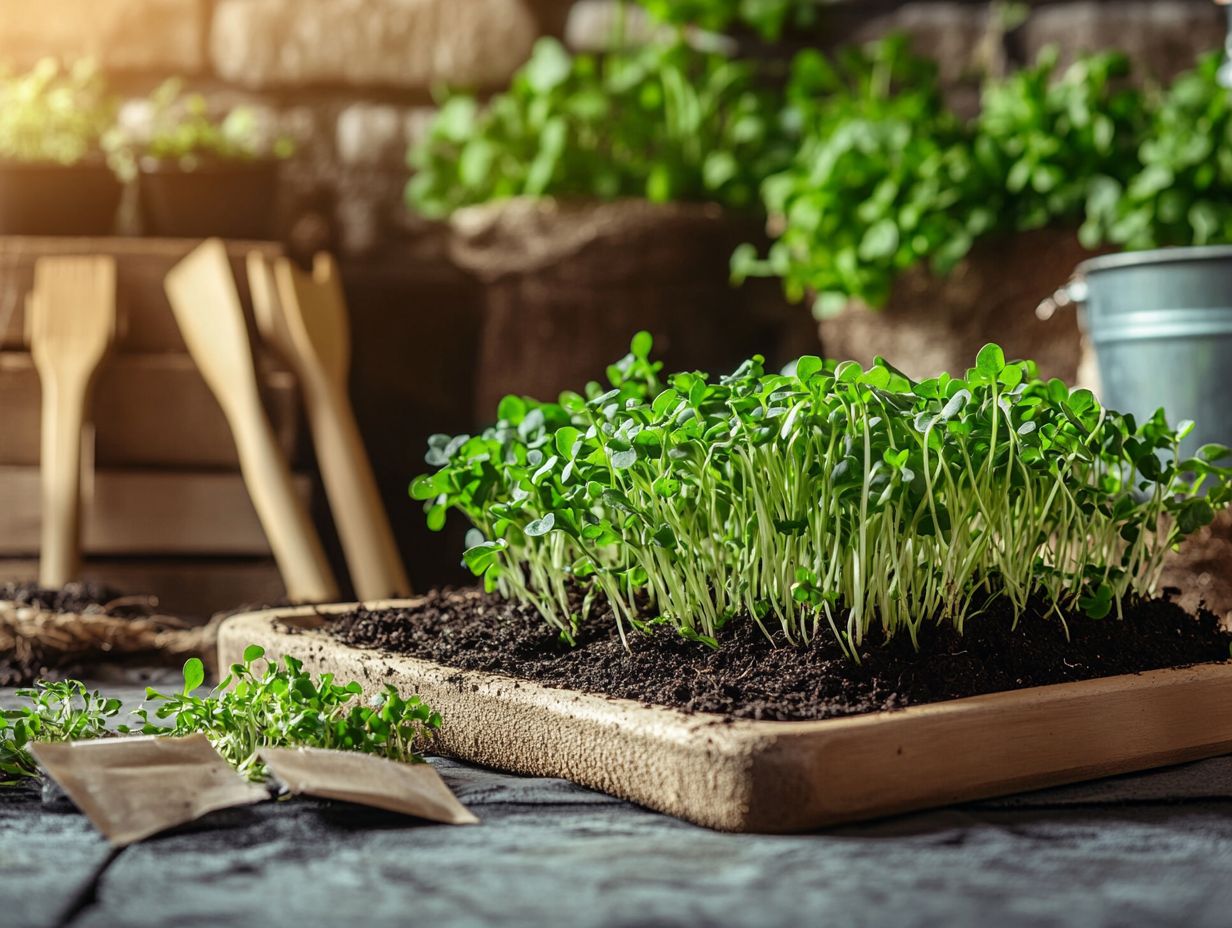
- Compost
- Seaweed extract
- Fish emulsion
- Manure
- Worm castings
- Bone meal
- Blood meal
How often should natural fertilizers be applied to microgreens?
It is recommended to apply natural fertilizers every two weeks during the growing season. However, monitor the health of your microgreens and adjust the frequency of fertilization accordingly.
Can natural fertilizers be harmful to microgreens if overused?
Yes, using too much fertilizer, including natural ones, can harm microgreens. This can lead to nutrient burn, stunted growth, or even plant death.
Follow the instructions on the fertilizer package to keep your microgreens thriving!
Are natural fertilizers safe for consumption in microgreens?
Yes, natural fertilizers are safe for microgreens. They are made from organic materials and do not contain harmful chemicals.
However, always wash and clean your microgreens before eating them.
Are natural fertilizers more expensive than chemical fertilizers?
Natural fertilizers may cost a bit more than chemical ones. Yet, they provide long-term benefits for your microgreens and the environment.
This makes them a smart choice for sustainable and healthy growth!

